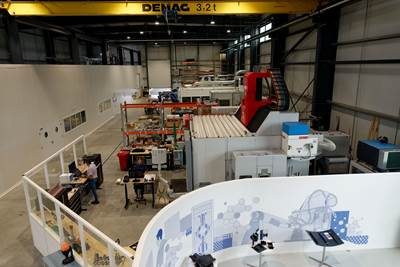Tooling foam, core excels in uniformity, high temps and repeated curing
CAMX 2024: General Plastics Manufacturing Co. returns with advancements to its Last-a-Foam tooling board foam and composite core products.
Share
Source | General Plastics Manufacturing Co.
General Plastics Manufacturing Co. (Tacoma, Wash., U.S.), a provider and manufacturer of rigid and flexible polyurethane foam sheet stock, built-to-print composite assemblies and finished custom parts, is exhibiting the latest advancements to its Last-a-Foam high-temperature tooling board foam and composite core products.
Last-a-Foam tooling board provides aerospace, automotive, marine and other composites manufacturing companies with a high-performance, consistently uniform material that can withstand high temperatures and repeated curing cycles. Affordable and dimensionally stable, this rigid foam board is ideal for prototype machining, high-temperature curing prepregs, vacuum forming, pattern making and other limited-run tooling where traditional metal dies are cost-prohibitive.
Available in 3-50-pound densities, this series is non-abrasive, can be machined with standard high-speed steel cutting tools into complex shapes and is available in custom sizes. It can also be cut cleanly with waterjets and traditional wood-carving tools. General Plastics also offers complete in-house production services that deliver tools machined to final specifications.
According to the company, Last-of-Foam core is renowned for its high strength, low weight and consistent properties. Its formulations are reported to offer a compelling alternative to traditional core materials, such as thermoplastic foam, honeycomb, wood and metal. General Plastics’ closed-cell, water-resistant core materials meet the requirements of numerous industries and complex applications such as FST/OSU-compliant foam core in aircraft interior sandwich panels; high strength-to-weight ratio core material for automotive load floors; dielectric material for radomes; buoyancy foam in subsea applications; and even impact-resistant core in hockey sticks.
General Plastics recently released a new composite core technical paper, which examines the factors to consider when choosing a core material for an application, which is available at .
Related Content
-
Airbus video highlights RACER compound helicopter first flight
Launched as part of a Clean Sky 2 program, a compound design — rotor, split fixed-wing, propulsive propellers — uses composites to cut fuel consumption and emissions by 20%.
-
Composites end markets: New space (2025)
Composite materials — with their unmatched strength-to-weight ratio, durability in extreme environments and design versatility — are at the heart of innovations in satellites, propulsion systems and lunar exploration vehicles, propelling the space economy toward a $1.8 trillion future.
-
Norco delivers GFRP hard hulled riverine craft for BAE Systems
Norco’s broad-ranging materials and manufacturing expertise revitalize UK MOD legacy craft, providing a solution for future defense and communications sector projects.
Related Content
Airbus video highlights RACER compound helicopter first flight
Launched as part of a Clean Sky 2 program, a compound design — rotor, split fixed-wing, propulsive propellers — uses composites to cut fuel consumption and emissions by 20%.
Read MoreComposites end markets: New space (2025)
Composite materials — with their unmatched strength-to-weight ratio, durability in extreme environments and design versatility — are at the heart of innovations in satellites, propulsion systems and lunar exploration vehicles, propelling the space economy toward a $1.8 trillion future.
Read MoreNorco delivers GFRP hard hulled riverine craft for BAE Systems
Norco’s broad-ranging materials and manufacturing expertise revitalize UK MOD legacy craft, providing a solution for future defense and communications sector projects.
Read MoreGuidance for the thermoforming process
A briefing on some of the common foam core material types, forming methods and tooling requirements.
Read MoreRead Next
ATL Composites collaboration advances kite-foil board production for Paris Olympics
Breiana Whitehead, pioneering Australian kite-foil sailor, spearheads board design intricacies with ATL Composites to enhance her performance ahead of the July 2024 competition.
Read MorePlant tour: Daher Shap’in TechCenter and composites production plant, Saint-Aignan-de-Grandlieu, France
Co-located R&D and production advance OOA thermosets, thermoplastics, welding, recycling and digital technologies for faster processing and certification of lighter, more sustainable composites.
Read MoreVIDEO: High-volume processing for fiberglass components
Cannon Ergos, a company specializing in high-ton presses and equipment for composites fabrication and plastics processing, displayed automotive and industrial components at CAMX 2024.
Read More









